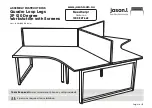
INTRODUCTION
Basic instructions - Chain Wear Tables - Roller Chains
CR10.90
NA
CR8.90
NA
CR9.90
NA
CX8.80
NA
CX8.90
NA
Chain Wear
The individual joints in a roller chain articulate as they enter and leave the sprockets. This articulation results in wear
on the pins and bushings. A material is worn away from these surfaces the chain will gradually elongate.
ZEIL10GH0003A0B
1
Chains do not "stretch" - material is removed from pin and bushing.
(1)
: 2x pitch
(2)
: 2x pitch + wear
(3)
: elongation due to pin and bushing wear.
Elongation is normal and may be minimized by proper lubrication and drive maintenance. The rate of wear is depen-
dent upon: the relationship between the load and the amount of bearing area between pin and bushing, the material
and surface condition of the bearing surfaces, the adequacy of lubrication and the frequency and degree of articulation
between pins and bushings.
The latter is determined by the quantity of sprockets in the drive, their speeds, the number of teeth and the length of
the chain in pitches.
ZEIL10GH0015A0A
2
Measurement of Chain For Wear Elongation
Relatively accurate wear measurements can be made by using the above illustration. Measure as closely as possi-
ble from the center of one pin to the center of another. The more pitches (pins) contained within the measurement
increase the accuracy. If the measured value exceeds the nominal by more than the allowable percentage the chain
should be replaced.
The maximum allowable wear elongation is approximately
3 %
for most industrial applications, based upon sprocket
design. The allowable chain wear in percent can be calculated using the relationship: 200/
(N)
, where
(N)
is the
number of teeth in the large sprocket.
47956065 17/05/2016
22
















































